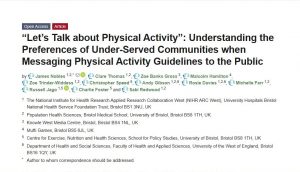Why talking about physical activity in the right way is more important than ever
23 April 2020
In this blog, Dr James Nobles talks about the Bristol recommendations for talking about physical activity, and how important this is in the context of the COVID-19 pandemic.
Daily “exercise” is one of the four reasons for leaving your home during the COVID-19 outbreak. Indoor exercise is also being promoted to help people with their physical and mental health, though at the time of writing we are still allowed out to exercise. (We’ll come on to the use of the word exercise later.)
All this means there’s been a surge in public-facing communications about physical activity, whether on our daily outings or in our living rooms. From PE with Joe Wicks at 9am every morning on YouTube to Sport England’s #StayInWorkOut campaign, the sector is adapting to try and promote the benefits of physical activity to the public.
Just over a year ago in what feels like an entirely different era, ARC West, in collaboration with Knowle West Media Centre and Mufti Games, started the “How Do You Move?” project. It aimed to understand how members of the public, particularly people who live in under-served areas, would prefer physical activity messages to be communicated to them.
We recently had our findings published in the International Journal of Environmental Research and Public Health. Here are our key recommendations, which we hope are useful for anyone promoting physical activity during the COVID-19 outbreak:
10 ways to improve your physical activity communication: the Bristol recommendations
- Work with multi-disciplinary teams, and ensure (social) marketers are involved
- Understand, and work with, your target audience to develop tailored messages
- Keep language simple. You may not need to include the physical activity guidelines!
- Promote the benefits of physical activity, including physical, mental and social health
- Identify influential and trustworthy individuals to deliver the message
- Use different mechanisms (eg posters, social media, TV) to spread a consistent message
- Terminology matters. Physical activity is more than just exercise and sport
- Consider how resources can be pooled between organisations to promote a consistent message
- Documents for healthcare professionals (eg infographics) are not designed for the public
- Reflect on current physical activity messages, and how they might be interpreted by the public
There is also some really great work that has just been published by colleagues from the University of Edinburgh in the International Journal of Behavioural Nutrition and Physical Activity. They asked a similar question to us, but rather than speaking with the public, they reviewed the published research. As you will see from their findings, many of their recommendations are consistent with those of coming from our project.
One consistent finding which is key to consider right now is the terminology that we use to talk about physical activity with the public. For many people, terms such as “exercise” and “sport” have many negative connotations attached to them. There is an opportunity now to make physical activity more inclusive, to move away from the perception that “exercise” is something that can only be done in a gym or on a run. Physical activity relates to movement, and there are many different ways in which people can move more. Finding something that is enjoyable is important.
Finally, to help support professionals who talk to the public about physical activity, the Chief Medical Officer’s Physical Activity Guidelines working group are offering a free service for anyone producing physical activity resources in the UK. The intention of this service is to help provide accurate, clear, consistent evidence statements on physical activity.
One outcome of the COVID-19 outbreak could be that more people incorporate physical activity into their daily lives. These resources will help any professionals who are in the business of promoting and advising on physical activity to do that as effectively as possible.
Paper
